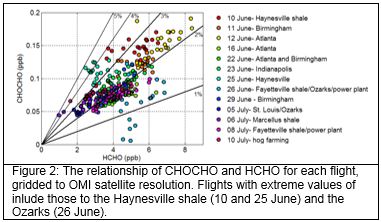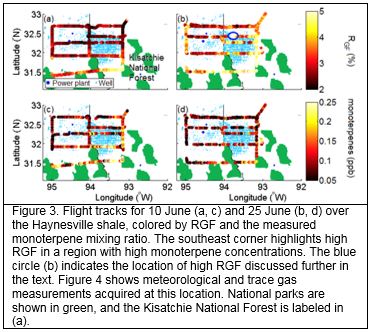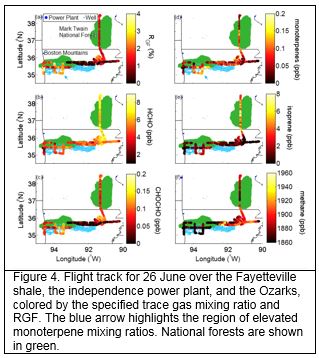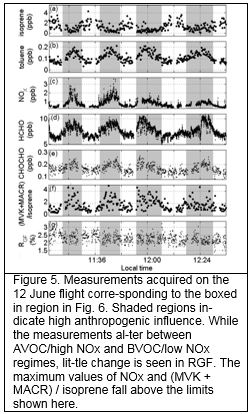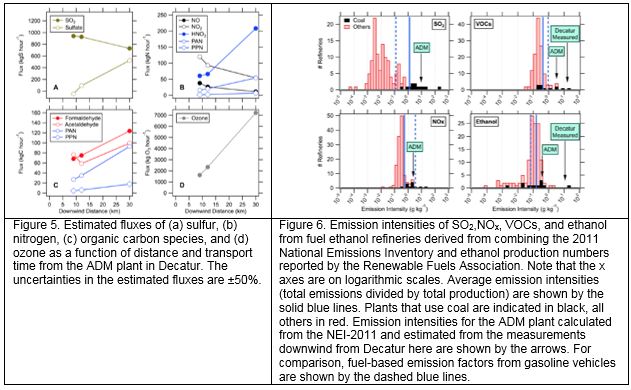Grantee Research Project Results
2014 Progress Report: Assessing anthropogenic impact on secondary pollutant formation in the South Eastern US via airborne formaldehyde measurements
EPA Grant Number: R835406Title: Assessing anthropogenic impact on secondary pollutant formation in the South Eastern US via airborne formaldehyde measurements
Investigators: Keutsch, Frank N
Institution: University of Wisconsin - Madison
EPA Project Officer: Chung, Serena
Project Period: April 1, 2013 through March 31, 2015 (Extended to March 31, 2016)
Project Period Covered by this Report: April 1, 2014 through March 31,2015
Project Amount: $194,183
RFA: Anthropogenic Influences on Organic Aerosol Formation and Regional Climate Implications (2012) RFA Text | Recipients Lists
Research Category: Air Quality and Air Toxics , Air , Climate Change
Objective:
The primary objective of the proposed work is to improve our mechanistic understanding of the anthropogenic influence on processes transforming primary emissions into secondary pollutants, especially ozone and secondary organic aerosol (SOA), and to constrain the temporal and spatial scales of this anthropogenic impact in the southeastern United States (SE US). Specifically, airborne measurements of formaldehyde, in conjunction with a full suite of chemical and meteorological observations, will be used to evaluate the impact of anthropogenic volatile organic carbon (VOC) and nitrogen oxide (NOx) emissions on ozone and SOA production efficiency at the urban-rural interface. Analysis will focus on quantifying the degree of fragmentation versus functionalization, and the related extent of chain terminating reactions during the photochemical lifecycle of biogenic and anthropogenic VOCs. These factors determine the relative ozone production rates and mass of reactive carbon in the gas and condensed phases. We will evaluate how synergistic and competitive mechanisms interact to influence SOA loadings and optical properties. Formaldehyde measurements also will enable improved isoprene emission models that can then be used as a reference for isoprene inferred from formaldehyde via satellite retrievals, which are critical to regional models of air quality. The objectives of the research have not changed from the original application, and there has been no change in key personnel.
Progress Summary:
In year 2, detailed analysis of the SENEX flight observations within the context of anthropogenic influence was initiated. Important findings were submitted for publications in year 2 both from our team and from collaborators using our observations. Additional analysis was conducted with manuscripts now submitted/being submitted by our team as well as by SENEX collaborators. The work under this grant was highly successful and will contribute to a large number of peer reviewed publications and substantial advancement of our understanding of anthropogenic influence on secondary pollutant formation. Key findings were: Formaldehyde and glyoxal concentrations and the ratio of glyoxal to formaldehyde can provide a valuable tracer for the speciation of reactive VOC driving secondary pollutant formation as well as anthropogenic influence via NOx.
1. Reassessing the ratio of glyoxal to formaldehyde as an indicator of hydrocarbon precursor speciation(Kaiser et al., Atmos. Chem. Phys., 15, 7571–7583, 2015)
The yield of formaldehyde (HCHO) and glyoxal (CHOCHO) from oxidation of volatile organic compounds (VOCs) depends on precursor VOC structure and the concentration of NOx (NOx = NO + NO2). Previous work has proposed that the ratio of CHOCHO to HCHO (RGF) can be used as an indicator of precursor VOC speciation, and absolute concentrations of the CHOCHO and HCHO as indicators of NOx. Because this metric is measurable by satellite, it is potentially useful on a global scale; however, absolute values and trends in RGF have differed between satellite and ground-based observations. To investigate potential causes of previous discrepancies and the usefulness of this ratio, we analyzed measurements of CHOCHO and HCHO over the SE US from the 2013 SENEX (Southeast Nexus) flight campaign (Fig. 1), and compared these measurements with OMI (Ozone Monitoring Instrument) satellite retrievals. Our high time-resolution flight measurements show that high RGF is associated with monoterpene emissions, low RGF is associated with isoprene oxidation, and emissions associated with oil and gas production can lead to small-scale variation in regional RGF (Fig. 2-4). During the summertime in the SE US, RGF is not a reliable diagnostic of anthropogenic VOC emissions, as HCHO and CHOCHO production are dominated by isoprene oxidation. However, this also reflects the fact that anthropogenic VOC oxidation is of low significance compared to isoprene oxidation with respect to ozone production and overall oxidation rate. Our results show that the new CHOCHO retrieval algorithm reduces the previous disagreement between satellite and in situ RGF observations. As the absolute values and trends in RGF observed during SENEX are largely reproduced by OMI observations, we conclude that satellite-based observations of RGF can be used alongside knowledge of land use as a global diagnostic of dominant hydrocarbon speciation.
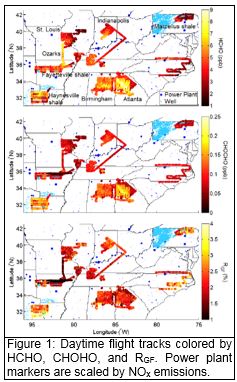
Overall, the flight-based measurements presented here show that RGF can be indicative of VOC speciation. High RGF (> 3 %) is consistently observed in areas with high monoterpene emissions, and low RGF (< 2.5 %) is associated with strong isoprene emissions. The previously observed fast and short (2–5 min) increase in RGF in Di-Gangi et al. (2012) may have been a result of extremely fresh emissions (e.g., diesel trucks emit at a rate of CHOCHO / HCHO = 9.4 %; Schauer et al., 1999), and not indicative of larger scale changes in dominant VOC speciation. Emissions associated with oil and gas production areas can cause RGF to deviate from the values observed over their background levels (Fig. 2-4). However, the absolute value of RGF in such regions is likely dependent on background BVOC emissions, speciation of AVOCs, and any direct OVOC emissions.
Compared to previous literature, absolute values of flight-based RGF are in better agreement with satellite observations using the new CHOCHO retrieval algorithms. Although time resolution plays a large role in direct comparisons of point-based measurements and satellite retrievals, the trend of high RGF over areas with monoterpenes and low RGF over areas with isoprene is broadly in agreement for the two platforms. With these trends validated by ground measurements, RGF based on satellite retrievals may be useful as a diagnostic of BVOC emissions. As these retrievals become available at higher time and spatial resolutions, RGF can be used to help identify the speciation of VOCs leading to secondary pollutant formation on a regional scale.
The previously discussed analysis demonstrates that RGF reflects the dominant VOCs, in the SE US often isoprene, and this makes small-scale influence (e.g., of anthropogenic VOCs) hard to observe. However, the absolute concentration of formaldehyde and glyoxal represent a stronger tracer for anthropogenic influence via NOx within one dominant VOC domain. Figure 5 shows for multiple intersections of an urban plume with high NOx within an isoprene dominated airmass. Whereas the RGF values (inset g) remain unchanged, as isoprene continues to be the dominant VOC, the absolute concentrations are clearly increased as a result of anthropogenic NOX. This likely results from increased oxidant concentrations, resulting in faster VOC oxidation chemistry, consistent with the lower isoprene concentrations and higher oxidation product to isoprene ratios, which reflects how oxidized the VOCs are in the airmass. This is an important result within the context of secondary pollutant formation as the oxidation processes forming formaldehyde are directly coupled to the formation of secondary pollutants.
Jennifer Kaiser, a Keutsch group graduate student, published this important work providing a framework for evaluating anthropogenic influence and VOC speciation on a regional scale in Atmospheric Chemistry and Physics.
2. Airborne measurements of the atmospheric emissions from a fuel ethanol refinery (de Gouw et al., J. Geophys. Res., 120, doi:10.1002/ 2015JD023138 2015)
Joost de Gouw (NOAA, CIRES and UC Boulder) used our formaldehyde measurements as part of an analysis of ethanol emissions from fuel ethanol refineries.
Ethanol made from corn now constitutes approximately 10% of the fuel used in gasoline vehicles in the United States. The ethanol is produced in over 200 fuel ethanol refineries across the nation. DeGouw used airborne measurements, including formaldehyde, from the SENEX campaign downwind from Decatur, Illinois, where the third largest fuel ethanol refinery in the United States is located to estimate emissions of reactive VOCs, primarily ethanol. The estimated emissions were compared with the total point source emissions in Decatur according to the 2011 National Emissions Inventory (NEI-2011), in which the fuel ethanol refinery represents 68.0% of sulfur dioxide (SO2), 50.5% of nitrogen oxides (NOx =NO+NO2), 67.2% of volatile organic compounds (VOCs), and 95.9% of ethanol emissions. Emissions of SO2 and NOx from Decatur agreed with NEI-2011, but emissions of several VOCs were underestimated by factors of 5 (total VOCs) to 30 (ethanol). By combining the NEI-2011 with fuel ethanol production numbers from the Renewable Fuels Association, deGouw calculated emission intensities, defined as the emissions per ethanol mass produced. Emission intensities of SO2 and NOx are higher for plants that use coal as an energy source, including the refinery in Decatur. By comparing with fuel-based emission factors, we find that fuel ethanol refineries have lower NOx, similar VOC, and higher SO2 emissions than from the use of this fuel in vehicles. The VOC emissions from refining could be higher than from vehicles, if the underestimated emissions in NEI-2011 downwind from Decatur extend to other fuel ethanol refineries. Finally, chemical transformations of the emissions from Decatur were observed, including formation of new particles, nitric acid, peroxyacyl nitrates, aldehydes, ozone, and sulfate aerosol.
Joost de Gouw one of our SENEX collaborators at NOAA, Boulder, published this important finding in the Journal of Geophysical Research.
Also during this project period, additional analysis of anthropogenic influence on air quality in SE-US was initiated both by our group (Glenn Wolfe, Margaret Marvin) was conducted as well as by collaborators (Bin Yuan, Joost de Gouw at NOAA Boulder and Jingyi Li at GFDL Princeton) using our formaldehyde measurements in their analyses.
Key Findings under this grant: Successful formaldehyde measurements were obtained and data submitted to archive. We have successfully evaluated the capability of using RGF as an indicator of anthropogenic influence on secondary pollutant formation. In the SE US, VOC oxidation is dominated by isoprene so that RGF shows little variability (Kaiser et al. ACP 2015). However, the absolute concentration of formaldehyde reflects the rate of oxidative processing as a function of anthropogenic NOX (Wolfe and de Gouw et al. in preparation). Our observations and scientific results are being integrated into regional models (Jingyi Li, Marvin) and will provide an improved understanding of anthropogenic influence on secondary pollutant formation.
Future Activities:
The focus of year 3 is completion of the detailed analysis of anthropogenic influence on secondary pollutant formation in the SE US using the successfully obtained formaldehyde as well as other chemical and meteorological observations in conjunction with our chemical models. The AGU presentations listed above will be submitted as manuscripts in early 2016. One further extension of this work will be the investigation of anthropogenic influence on fragmentation versus functionalization during VOC oxidation as a function of anthropogenic influence.
Journal Articles on this Report : 2 Displayed | Download in RIS Format
| Other project views: | All 30 publications | 13 publications in selected types | All 13 journal articles |
|---|
| Type | Citation | ||
|---|---|---|---|
|
|
de Gouw JA, McKeen SA, Aikin KC, Brock CA, Brown SS, Gilman JB, Graus M, Hanisco T, Holloway JS, Kaiser J, Keutsch FN, Lerner BM, Liao J, Markovic MZ, Middlebrook AM, Min K-E, Neuman JA, Nowak JB, Peischl J, Pollack IB, Roberts JM, Ryerson TB, Trainer M, Veres PR, Warneke C, Welti A, Wolfe GM. Airborne measurements of the atmospheric emissions from a fuel ethanol refinery. Journal of Geophysical Research: Atmospheres 2015;120(9):4385-4397. |
R835406 (2014) R835406 (Final) |
Exit Exit Exit |
|
|
Kaiser J, Wolfe GM, Min KE, Brown SS, Miller CC, Jacob DJ, de Gouw JA, Graus M, Hanisco TF, Holloway J, Peischl J, Pollack IB, Ryerson TB, Warneke C, Washenfelder RA, Keutsch FN. Reassessing the ratio of glyoxal to formaldehyde as an indicator of hydrocarbon precursor speciation. Atmospheric Chemistry and Physics 2015;15(13):7571-7583. |
R835406 (2014) R835406 (Final) |
Exit Exit Exit |
Supplemental Keywords:
Formaldehyde, secondary pollutant formation, ozone, anthropogenic influenceProgress and Final Reports:
Original AbstractThe perspectives, information and conclusions conveyed in research project abstracts, progress reports, final reports, journal abstracts and journal publications convey the viewpoints of the principal investigator and may not represent the views and policies of ORD and EPA. Conclusions drawn by the principal investigators have not been reviewed by the Agency.

